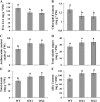SAUR39, a small auxin-up RNA gene, acts as a negative regulator of auxin synthesis and transport in rice
- PMID: 19700562
- PMCID: PMC2754634
- DOI: 10.1104/pp.109.143875
SAUR39, a small auxin-up RNA gene, acts as a negative regulator of auxin synthesis and transport in rice
Abstract
The phytohormone auxin plays a critical role for plant growth by regulating the expression of a set of genes. One large auxin-responsive gene family of this type is the small auxin-up RNA (SAUR) genes, although their function is largely unknown. The expression of the rice (Oryza sativa) SAUR39 gene showed rapid induction by transient change in different environmental factors, including auxin, nitrogen, salinity, cytokinin, and anoxia. Transgenic rice plants overexpressing the SAUR39 gene resulted in lower shoot and root growth, altered shoot morphology, smaller vascular tissue, and lower yield compared with wild-type plants. The SAUR39 gene was expressed at higher levels in older leaves, unlike auxin biosynthesis, which occurs largely in the meristematic region. The transgenic plants had a lower auxin level and a reduced polar auxin transport as well as the down-regulation of some putative auxin biosynthesis and transporter genes. Biochemical analysis also revealed that transgenic plants had lower chlorophyll content, higher levels of anthocyanin, abscisic acid, sugar, and starch, and faster leaf senescence compared with wild-type plants at the vegetative stage. Most of these phenomena have been shown to be negatively correlated with auxin level and transport. Transcript profiling revealed that metabolic perturbations in overexpresser plants were largely due to transcriptional changes of genes involved in photosynthesis, senescence, chlorophyll production, anthocyanin accumulation, sugar synthesis, and transport. The lower growth and yield of overexpresser plants was largely recovered by exogenous auxin application. Taken together, the results suggest that SAUR39 acts as a negative regulator for auxin synthesis and transport.
Figures






Comment in
-
Auxin-responsive SAUR39 gene modulates auxin level in rice.Plant Signal Behav. 2009 Dec;4(12):1174-5. doi: 10.4161/psb.4.12.10043. Plant Signal Behav. 2009. PMID: 20514239 Free PMC article.
Similar articles
-
Auxin-responsive SAUR39 gene modulates auxin level in rice.Plant Signal Behav. 2009 Dec;4(12):1174-5. doi: 10.4161/psb.4.12.10043. Plant Signal Behav. 2009. PMID: 20514239 Free PMC article.
-
The small auxin-up RNA OsSAUR45 affects auxin synthesis and transport in rice.Plant Mol Biol. 2017 May;94(1-2):97-107. doi: 10.1007/s11103-017-0595-7. Epub 2017 Mar 20. Plant Mol Biol. 2017. PMID: 28321650
-
OsNAC121 regulates root development, tillering, panicle morphology, and grain filling in rice plant.Plant Mol Biol. 2024 Jul 2;114(4):82. doi: 10.1007/s11103-024-01476-3. Plant Mol Biol. 2024. PMID: 38954114
-
Auxin and monocot development.Cold Spring Harb Perspect Biol. 2010 Mar;2(3):a001479. doi: 10.1101/cshperspect.a001479. Cold Spring Harb Perspect Biol. 2010. PMID: 20300208 Free PMC article. Review.
-
New insight into the biochemical mechanisms regulating auxin transport in plants.Biochem J. 2007 Feb 1;401(3):613-22. doi: 10.1042/BJ20061411. Biochem J. 2007. PMID: 17209803 Free PMC article. Review.
Cited by
-
Genome-wide association study and transcriptome analysis reveal key genes controlling fruit branch angle in cotton.Front Plant Sci. 2022 Sep 21;13:988647. doi: 10.3389/fpls.2022.988647. eCollection 2022. Front Plant Sci. 2022. PMID: 36212380 Free PMC article.
-
SUPPRESSOR OF PHYTOCHROME B4-#3 Represses Genes Associated with Auxin Signaling to Modulate Hypocotyl Growth.Plant Physiol. 2016 Aug;171(4):2701-16. doi: 10.1104/pp.16.00405. Epub 2016 Jun 24. Plant Physiol. 2016. PMID: 27342309 Free PMC article.
-
SAUR Proteins as Effectors of Hormonal and Environmental Signals in Plant Growth.Mol Plant. 2015 Aug;8(8):1153-64. doi: 10.1016/j.molp.2015.05.003. Epub 2015 May 15. Mol Plant. 2015. PMID: 25983207 Free PMC article. Review.
-
Relationship between gene responses and symptoms induced by Rice grassy stunt virus.Front Microbiol. 2013 Oct 18;4:313. doi: 10.3389/fmicb.2013.00313. eCollection 2013. Front Microbiol. 2013. PMID: 24151491 Free PMC article.
-
TCP transcription factors regulate the activities of ASYMMETRIC LEAVES1 and miR164, as well as the auxin response, during differentiation of leaves in Arabidopsis.Plant Cell. 2010 Nov;22(11):3574-88. doi: 10.1105/tpc.110.075598. Epub 2010 Nov 30. Plant Cell. 2010. PMID: 21119060 Free PMC article.
References
-
- Abel S, Nguyen MD, Theologis A (1995) The PS-IAA4/5-like family of early auxin-inducible mRNAs in Arabidopsis thaliana. J Mol Biol 251: 533–549 - PubMed
-
- Arite T, Iwata H, Ohshima K, Maekawa M, Nakajima M, Kojima M, Sakakibara H, Kyozuka J (2007) DWARF10, an RMS1/MAX4/DAD1 ortholog, controls lateral bud outgrowth in rice. Plant J 51: 1019–1029 - PubMed
Publication types
MeSH terms
Substances
Associated data
- Actions
LinkOut - more resources
Full Text Sources
Other Literature Sources
Molecular Biology Databases

